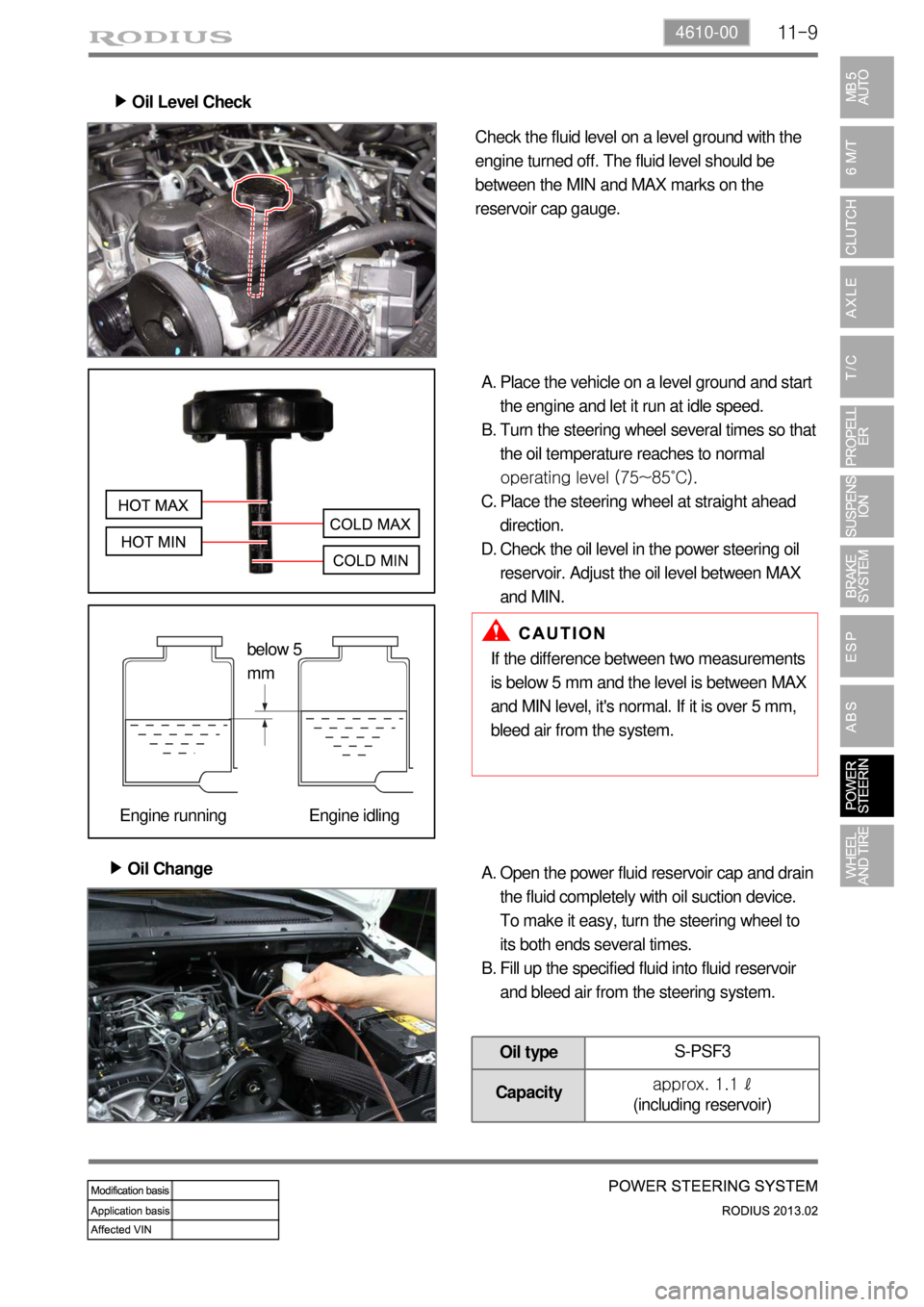Page 638 of 796
08-114850-03
Clean the dissembled components and visually check the followings:
- Wear, rust and damage on the cylinder and piston
- Damage, crack and wear on cylinder body and guide pin
- Uneven wear and oil contamination on pad
- Damage and tear on boot
- Scratch and bending on disc plate
Remove the rear tire.
Measure the pad thickness and replace it if it
is below the wear limit. 1.
2.
New pad Wear limit
20.0 mm 18.4 mm
Replace the brake pads at both sides as a
set.
Measure the disc thickness at over ten
points.
If any of measured points is below the wear
limit, replace the brake disc with new one. 1.
2.
New pad Wear limit
10 mm 2 mm
2) Rear Brake System
Pad Thickness ▶
Brake Disc Thickness ▶
Page 691 of 796

11-94610-00
Oil Level Check ▶
Check the fluid level on a level ground with the
engine turned off. The fluid level should be
between the MIN and MAX marks on the
reservoir cap gauge.
Place the vehicle on a level ground and start
the engine and let it run at idle speed.
Turn the steering wheel several times so that
the oil temperature reaches to normal
operating level (75~85˚C).
Place the steering wheel at straight ahead
direction.
Check the oil level in the power steering oil
reservoir. Adjust the oil level between MAX
and MIN. A.
B.
C.
D.
Oil Change ▶
If the difference between two measurements
is below 5 mm and the level is between MAX
and MIN level, it's normal. If it is over 5 mm,
bleed air from the system.
Open the power fluid reservoir cap and drain
the fluid completely with oil suction device.
To make it easy, turn the steering wheel to
its both ends several times.
Fill up the specified fluid into fluid reservoir
and bleed air from the steering system. A.
B.
Oil typeS-PSF3
Capacityapprox. 1.1 ℓ
(including reservoir)
below 5
mm
Engine running Engine idling
Page 692 of 796
11-10
Air Bleeding ▶
The air bleeding should be done after servicing
the power steering system and when the
difference between two measurements (cooled
and normal temperature) is prominent.
Normal
AbnormalLift up the vehicle very carefully.
Turn the steering wheel to its both ends
several times and add the oil up to MAX line
in the steering oil reservoir.
Periodically crank the starting motor and turn
the steering wheel to its both ends without
any interruption.
Check the oil level again. If the oil level is
fluctuated, repeat the procedures from step
3 to step 5.
Start the engine.
Turn the steering wheel to its both ends until
any bubble can be found in the steering oil
reservoir.
Perform the test drive and check the
steering wheel for normal operation and
noise.
If the oil level abruptly goes up, bleed the air
from the system again. A.
B.
C.
D.
E.
F.
G.
H.
If the air bleeding is not properly performed,
the life span of the power steering pump
may be shortened. -
Page 693 of 796
11-114610-00
Oil Pump Pressure Check ▶
Check the oil pump pressure to locate any
defect in oil pump.
Before checking the pressure, check the oil
level and belt tension. Prepare the empty
container to collect the spilled oil during the
service.
Unscrew the pressure line fitting in power
steering pump.
Install the pressure gauge between the
power steering pump and the power steering
oil pressure line.
Place the shift lever to neutral position. Apply
the parking brake.
Open the valve in pressure gauge. Start the
engine and let it run at idle speed.
Turn the steering wheel several times so that
the oil temperature reaches to normal
operating level. A.
B.
C.
D.
E.
Fully close the valve in pressure gauge and
measure the oil pressure. F.
To prevent internal damage, do not close the
gauge valve over 10 seconds.
Keep the oil temperature at proper range. -
-
Relief pressure93.3 ~ 100.4 kgf/cm²
Page:
< prev 1-8 9-16 17-24